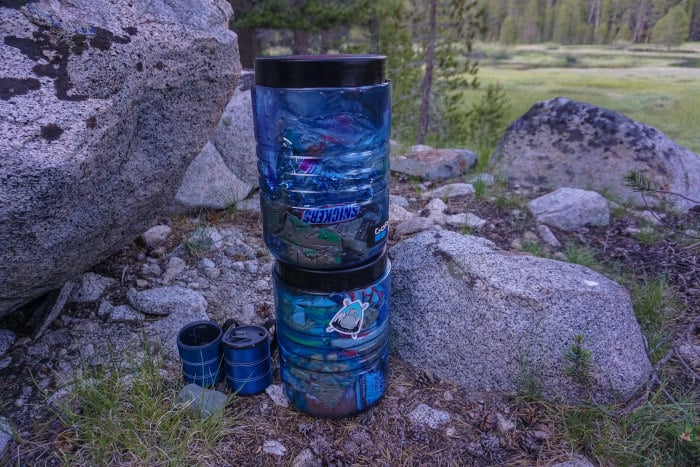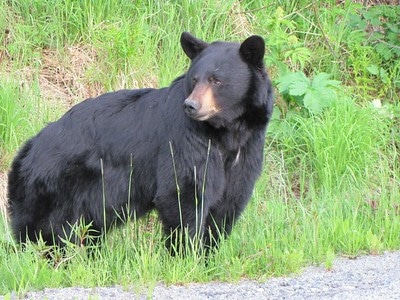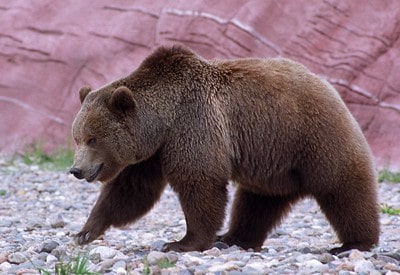Hiking and Backpacking In Bear Country: What You Need to Know
Where we live and hike in Idaho, the presence of black bears and grizzly bears is a constant reality. While I absolutely love that these living embodiments of wilderness still inhabit our mountain ranges, they also come with some concerns. Bears have the potential to be very dangerous, and to those unfamiliar with them can be downright scary.
Thankfully, there are some things you can do to minimize danger when hiking and backpacking in bear country. None of them are a one-size-fits-all approach, but combined they can make an intimidating situation a much more comfortable one.
Note: As an Amazon associate I earn from qualifying purchases. If you click through one of the links on this page and make a purchase, we receive a small commission at no extra cost to you. It helps keep us up and running and able to continue to provide great content. 🙂
Plan Ahead
The first thing to do when hiking in bear country is to plan ahead. Take some time to get familiar with the prevalence of bears in your area, as well as the species distribution. Black bears are generally less of a threat than grizzly bears, so know what to expect and know the difference.
Then, check up on the regulations in your area. Some places, including most National Parks, require some kind of bear-proof food storage. It depends on the park what types are approved (Hard-sided containers are required in Yosemite, while Ursacks are allowed in Grand Teton), so check ahead.
Some places (like Yosemite and Sequoia/Kings Canyon) also prohibit bear spray, so keep that in mind if having bear spray is important to your feeling safe.
How to Avoid Bear Encounters
The best way to be safe in bear country is to avoid bear encounters altogether. As with any wildlife, bears are unpredictable, but there are a few things you can do to limit your exposure.
Make noise while you hike
Most bears want to avoid you as much as you want to avoid them. Make your presence known by making plenty of noise while you hike. There are different ways of doing this but talking loudly is probably the most effective, because human speech is unfamiliar to wild bears. Many people carry bear bells, which jingle as you walk, but a study by bear biologist Tom Smith suggests that these may not actually work. What Smith did find effective was breaking sticks, so if hiking solo, whacking downed trees or rocks with a stick or trekking pole might be better.
Avoid hiking in the early morning or late evening
Bears, like most wildlife, are most active during these hours. Try not to hike at these times, especially in areas with low visibility.
Hike in larger groups
If, by chance, you are noticed by an aggressive bear, a larger group will make it less likely to charge or attack.
Stay aware and alert
Most bear attacks happen when a bear is surprised (often near food or cubs). Doing all of the above will help avoid surprises, but it’s helpful to keep your head up and eyes peeled so you have a better chance of seeing a bear before you’re too close.
Cut out scented soaps
You might not think it, but if your shampoo smells like a fruit a bear might want to eat, then they could head straight to your tent. It’s best to keep scented soaps of any kind to a minimum, and use unscented (like this from Dr. Bronners) if possible.
Cook and clean dishes away from camp
Cooking food is a surefire way to send food scent up into the air, so cook food away from camp if possible. That way if a bear comes in to the smell, they’ll show up where you cooked, and not where you’re sleeping.
Practice proper food storage techniques
This is hands down the most important strategy for avoiding bear encounters. Bears have an incredible sense of smell, and if they are able to get access to your food they can become very aggressive. More on food storage techniques below.
How To Properly Store Food In Bear Country

Storing food properly is the biggest key to staying safe in bear country. A bear’s sense of smell is about 7 times greater than a bloodhound’s (which are used to track animals and even missing people), so if you have food, bears can smell it from miles away.
The main goal of food storage isn’t necessarily to prevent the bear from smelling the food, but to prevent it from being able to eat it. Bears are territorial and food aggressive, so once a bear starts consuming your food, it is much more likely to become aggressive toward you and be aggressive towards other people in the future.
The saying “a fed bear is a dead bear,” isn’t just a catchy phrase; bears who are known to have had access to human food are regularly killed by game managers for the safety of people who use the area.
There are many food storage options, but here are the main ones:
Pre-installed storage boxes
In many high use campsites (often in National Parks) there are bear-proof boxes pre-installed for your convenience. If these are available, they are by far the best option.
Hard-sided canisters
In many places (including Yosemite, SEKI, and Yellowstone), hard-sided canisters are required. They are strong enough that a bear can’t break them and have bear-proof locks to keep them closed. We use the BV500 (pictured above). It's heavy, but it's approved almost everywhere and is the best option for longer trips.
Soft-sided bear-resistant bags
Ursack is the main company that makes soft, bear-resistant food bags. They are made of kevlar and theoretically will keep a bear from accessing your food. This is a claim that is disputed (and Ursacks aren’t allowed in many National Parks), but in low-density areas, I’m generally a fan. The best option for bears is the Ursack AllMitey.
Odor-proof bags
I want to be clear that odor-proof bags (like these from LOKSAK) are NOT a replacement for a bear-proof storage container. What they are good for is minimizing the chance that a bear will smell your food. This makes it less likely that you’ll have to shoo a bear away from your camp in the middle of the night. I pretty much always use them because there’s really no reason not to.
Bear hangs
Bear hangs are pretty self-explanatory: hang your food up high to keep bears from getting to it. While this is one of the most widely taught food storage methods, it has many issues, and I don’t advocate for it. More on that below.
When I’m in bear country, I always carry a hard-sided canister (currently the BV500) or Ursack if food lockers aren’t available. Which one I take depends on bear density, general food aggressiveness (Yosemite bears are crafty and known to get into people food), and bear species. I also combine it with an odor proof Opsack, just to reduce the odds of having an encounter.
Whatever method you choose, make sure that everything smelly (including scented soaps, food waste, and candy wrappers) goes in the can or bag. Then store the can somewhere relatively secure (like, not on the top of a cliff) around 100 feet downwind of your campsite. That way if a bear does come in, they won’t be coming through your campsite first.
On BEar Hangs:
Bear hangs are the traditional method of food storage. The general idea is that if you can get your food high enough up and far enough away from a tree trunk (because black bears do climb), it will be safe from bears.
The key word there is if.
Leave No Trace recommends hanging a bag at least 12 feet from the ground, 6 feet from the trunk, and 6 feet from the supporting limb. That means you need to find a tree with a strong branch that’s at least 18 feet high, and then figure out how to get your food up there and make sure it stays.
I’ve spent a lot of nights backpacking, and I would say somewhere between 30%-40% of those nights, a bear hang would’ve been impossible. In another 30%-40%, it would have been exceedingly difficult or time-consuming. There just often aren’t any trees that fit the bill. And if there are, it takes know-how and determination to actually do it right. It’s due directly to the fallibility of hangs that many National Parks require hard-sided canisters.
That means you probably shouldn’t rely on them either.
Bear Identification: Black Bear vs. Grizzly Bear
Knowing the difference between bears is important, because you’ll handle the situation differently for each type of encounter. They’re fairly easy to differentiate, but it does take a little bit of practice.
Black bears are the more common species. They are found throughout much of North America, and are generally smaller and less dangerous than grizzly bears. They can be identified by:
- Tall, pointed ears
- Long, straight face
- Lack of a shoulder hump
They may be called “black” bears, but color isn’t a good identifier. I’ve encountered several black bears that were very brown, including one in the Sierra that had the ‘classic grizzly’ color profile.
Grizzly bears are less common, and mainly found in Alaska, western Montana, northwestern Wyoming, and northern Idaho (and possibly northwestern Washington, in the North Cascades, as well as most of British Columbia and Alberta in Canada). They are generally larger and more dangerous than black bears and can be identified by:
- Round, “dished” face
- Short, round ears
- Large shoulder hump
Again, color is not a good identifier. Grizzly bears are more consistent in their coloring than black bears, but even grizzlies can be jet-black as well.
Bear Attack Deterrents

I always carry some form of bear attack deterrent when hiking in bear country. There are a few options, and you may want to carry one or several.
Bear Spray
The most well-known and most common bear deterrent, bear spray (also called bear mace) is very similar to pepper spray. It works by causing painful irritation to the bear's eyes and nose, usually resulting in the bear retreating. While it actually has a lower concentration of the active chemical than pepper spray, it’s designed to create a large cloud, making it more useful for charging bears. It was determined to be 92% effective at deterring bear attacks in an analysis of 647 encounters (done by bear biologist Tom Smith). It also saved this woman’s life during a near-fatal grizzly attack, where the bear literally chomped down on her head (she was able to spray over her shoulder, and it worked immediately). I always carry it in bear country (except where prohibited), because in the case that a bear really is too close, it’s the best option. UDAP, Frontiersman, and Counter Assault are all good options.
Bear Horn
A bear horn is a very loud horn powered by compressed air. Bears generally don’t like loud, high pitched noises, so these can be effective at getting a black bear to leave an area. It can be used if a bear is at an uncomfortably close distance, or if it’s showing signs of possible aggression. Horns like these for boating safety work just as well as the ones made specifically for bears. Note: bear horns should be used on black bears only.
Other Noisemakers
Anything that can be used to make loud, raucous noise can deter bears. Banging together pots and pans or large rocks can be effective. You can also yell, or even bark like a dog (which anecdotally seems to work even better, believe it or not). Again, black bears only.
Firearms
Many people like to carry a large caliber pistol (like a .44 Magnum or larger) as their deterrent of choice. While a .44 can theoretically stop a bear, I think guns are a bad choice for a couple reasons. The first and most important is that even for an experienced shooter, hitting a moving target at even relatively close distances is difficult and unreliable. This difficulty is compounded by the stress of the situation. The second is that even if you do hit the bear, you may unnecessarily wound it and still get attacked. A very angry, 700+ pound animal isn't likely to stop short with a minor flesh wound. And the third is just that guns and ammo are damn heavy, and I’d prefer not to carry an extra 5+ pounds when backpacking. TL;DR: Bear spray is almost always more effective than a handgun.
What to do if you encounter a bear
So you took all the steps to avoid a bear, but you encounter one anyway. What do you do?
A lot of what you should do depends on the type of bear. But if you do run into one, there are a few things you should do regardless of species.
- Do not approach; even if the bear is a long way off (and especially if it’s a bear with cubs).
- Reroute your hike if possible. If the only option is to move forward and the bear is some distance off trail (100+ yards), make a VERY wide circle, always increasing distance between you and the bear as you go. If you have to bushwhack to do it, then so be it.
- Never make direct eye contact; bears see this as an act of aggression
- Tighten up your group (if traveling in a group) to appear larger.
- Put on your pack for extra protection in case of attack.
- Ready your bear spray/deterrent.
Black bears and grizzly bears are different beasts, so they require slightly different approaches (remember to do all of the above as well).
What to do if you encounter a black bear
- Appear as large as possible
- Yell, make noise, and throw objects (not directly at the bear, but close by)
- Slowly back away
- If you have open food, lock it in a canister or carry it with you (the situation will be much worse if you let it get your food).
- Grab a knife or stick to have ready as last-resort defense
And if none of these things work and the bear moves very close/attacks/charges:
- Drop any food
- Continue to yell as loud as you can (loud, sharp “Hey!”s repeated quickly)
- If it’s charging towards you, begin deploying bear spray when the bear is roughly 30 feet away. Bear spray works for about 7 seconds, so this is close enough for the initial spray to reach the bear and increase the potency of the cloud as it gets closer.
- If the bear attacks you, fight back with everything you have. It has decided you are prey, so DO NOT play dead (this is rare, but definitely worth addressing).
What to do if you encounter a grizzly bear
- Talk to the bear in low tones; loud, sharp noises can be seen as a threat and trigger an attack.
- Appear as unthreatening as possible
- Back away slowly
If the bear bluff charges:
- A bluff charge looks different from a full-on attack. The bear’s ears and head will be up, it will huff and make noise, and it will move toward you in leaps and bounds. It will usually stop short of bear spray distance.
- Continue talking in low, measured tones
- Do not run
If the bear attacks:
- An attack charge will likely be a full sprint. Its head and ears will be low and it won’t likely make noise.
- Deploy bear spray when the bear is roughly 30 feet away.
- If the bear spray fails, play dead. Grizzly attacks are almost always to eliminate a threat, not to predate.
- Lay flat on your stomach with your hands on your neck. If the bear rolls you and you can’t stay flat, try the cannonball position (with hands on your neck).
Bear attacks are desperate situations, so it’ll be hard to remember all of these things. But hopefully, this information will give you a little more knowledge and some things to keep in mind when hiking in bear country.
Final tips:
- Avoid hiking solo in grizzly country (I don’t always follow my own advice, like on my Wind River High Route trip, but I definitely prefer to be in a group).
- Make sure everyone in your group has bear spray; a bear can only attack one person at a time, so having friends to deploy spray during an active attack is essential.
- Take time to practice deploying bear spray (Frontiersman and Counter Assault both make practice bear spray canisters), and station it in an accessible area (bear spray does no good in the bottom of your pack; a chest mount is best).
- Never leave food unattended, even for a short time. We met a guy on the JMT who had his food stolen by a black bear less than ten yards from him while he turned around to pee (he actually got it back by yelling and banging stuff together; the bear dropped it and took off running!). Rare, but it happens.
- Keep an eye out for tracks (especially in snow) and scat. They'll let you know if bears are using the area.
Useful Resources/Links
If you think I missed something or got something wrong, let’s chat in the comments! I’m always happy to correct myself or add more useful info.



A interesting post there mate . Thank you for the post !